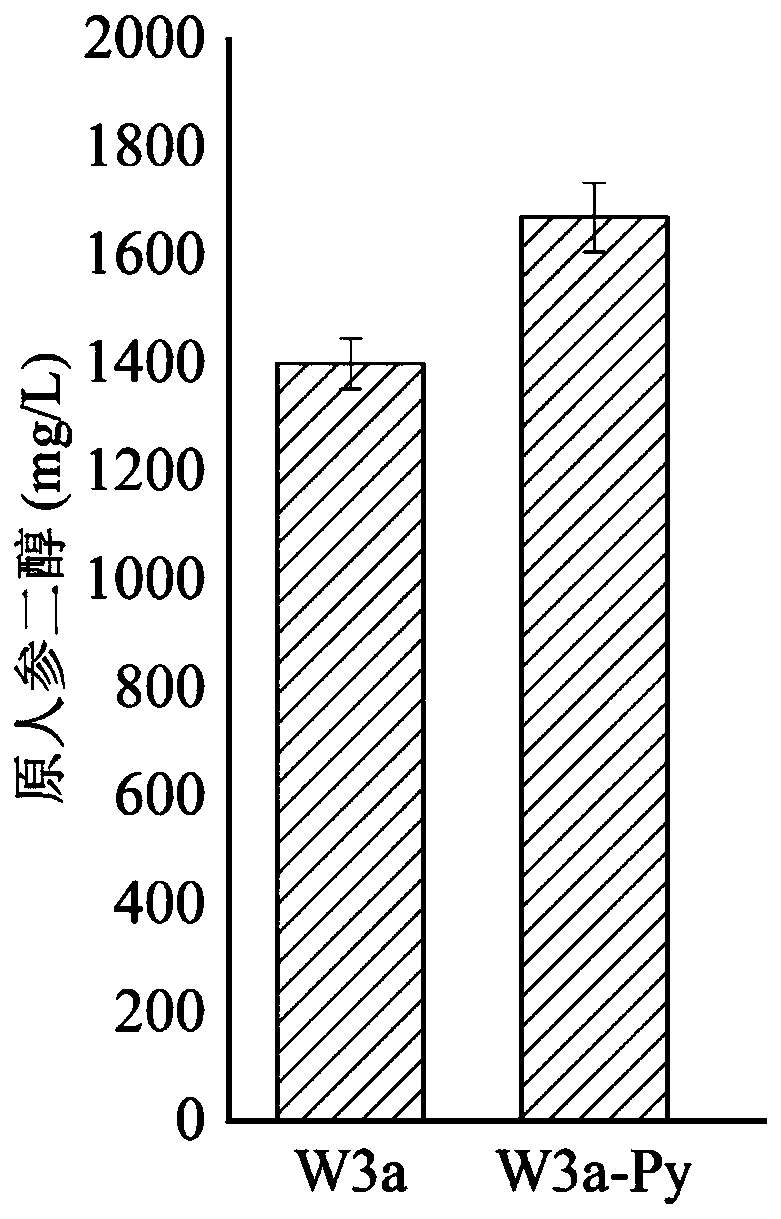Saccharomyces cerevisiae engineering strain for high yield of protopanaxadiol and construction method and use
A technology of protopanaxadiol and Saccharomyces cerevisiae, which is applied in the field of high-yielding protopanaxadiol Saccharomyces cerevisiae engineering strains and construction, which can solve the problems of cell growth toxicity and efficient synthesis of unfavorable products
- Summary
- Abstract
- Description
- Claims
- Application Information
AI Technical Summary
Problems solved by technology
Method used
Image
Examples
Embodiment 1
[0023] Example 1 Construction of the starting strain Saccharomyces cerevisiae engineered strain W3a-HU with high protopanaxadiol production:
[0024] W3a-HU is obtained by recovering the URA3 and HIS3 marker genes of W3a through plasmid pSH63.
[0025] Strains W3a and W2 come from the authorized patent ZL201410735927.X. The specific construction process of the strain can refer to this patent.
[0026] In the W3a strain, the URA3 and HIS3 markers have been utilized, but these two markers are flanked by two loxP sites. These two marker genes were first knocked out with the plasmid pSH63 expressing Cre protein (purchased from Biowind) to generate W3a-HU strain.
[0027] The specific operation adopts lithium acetate transformation, and the lithium acetate transformation method is as follows: after cultivating Saccharomyces cerevisiae W3a in 2mLYPD medium for 18 hours, inoculate it into a new YPD medium at an inoculation ratio of 10%, and continue culturing for 4 hours. Then, co...
Embodiment 2
[0038] Example 2 On the basis of the W3a-HU strain, the YBP1 gene was highly expressed (YBP1 is an oxidative stress regulator in Saccharomyces cerevisiae BY4741, the nucleotide sequence of the gene is shown in SEQ ID NO.11, from Saccharomyces cerevisiae Yeast BY4741 (USA, Number: 201388)), construct strain W3a-Py.
[0039] Construct gene Pgk1p-YBP1-Cyc1t gene expression cassette:
[0040] Using the Saccharomyces cerevisiae BY4741 genome as a template, using sequence 1 (SEQ ID NO.1) and sequence 2 (SEQ ID NO.2) as primers to amplify the Pgk1p promoter; using sequence 3 (SEQ ID NO.3) and sequence 4 (SEQ ID NO.4) was used as a primer to amplify the YBP1 gene; and sequence 5 (SEQ ID NO.5) and sequence 6 (SEQ ID NO.6) were used as primers to amplify the Cyc1t terminator. By fusion PCR method, the Pgk1p promoter, YBP1 gene and Cyc1t terminator were fused into a Pgk1p-YBP1-Cyc1t gene expression cassette.
[0041] Construction of the accessory fragments URA3r-Pgk1p and Cyc1t-URA3f...
Embodiment 3
[0047] The shake flask feeding fermentation process of embodiment 3 engineering bacteria
[0048] For fed-batch fermentation in shake flasks, each engineered strain was inoculated in a shake flask (250 mL) containing 30 mL of YPD medium, and cultured at 30° C. and 220 rpm. In the 48h of fermentation, add 5mL feeding solution, the composition of feeding solution is 500g / L glucose, 9g / L KH2PO4, 5.12g / L MgSO4 7H2O, 3.5g / LK2SO4, 0.28g / LNa2SO4, 0.5g / L adenine, 0.6g / L uracil, 1.2g / L lysine, 10mL / L trace element solution, 12mL / L vitamin solution. The composition of trace elements and vitamins is as follows:
[0049] Among them, the trace element composition and ratio are ( / L): EDTA 15g, ZnSO4 7H2O 10.2g, MnCl2 4H2O 0.50g, anhydrous CuSO40.5g, CoCl2 6H2O 0.86g, Na2MoO4 2H2O 0.56g, CaCl2 2H2O 3.84g and FeSO4.7H2O 5.12g.
[0050] Vitamin ingredients and ratios are ( / L): biotin 0.05g, calcium pantothenate 1g, nicotinic acid (nicotinic acid) 1g, inositol 25g, vitamin B11g, pyridoxine h...
PUM
| Property | Measurement | Unit |
|---|---|---|
| diameter | aaaaa | aaaaa |
Abstract
Description
Claims
Application Information
 Login to View More
Login to View More - Generate Ideas
- Intellectual Property
- Life Sciences
- Materials
- Tech Scout
- Unparalleled Data Quality
- Higher Quality Content
- 60% Fewer Hallucinations
Browse by: Latest US Patents, China's latest patents, Technical Efficacy Thesaurus, Application Domain, Technology Topic, Popular Technical Reports.
© 2025 PatSnap. All rights reserved.Legal|Privacy policy|Modern Slavery Act Transparency Statement|Sitemap|About US| Contact US: help@patsnap.com



